- Continue Shopping
- Your Cart is Empty
Delicata Squash Tart with Fried Sage and Caramelized Onions

What You'll Need
Equipment
- measuring cups and spoons
- good kitchen knife and clean cutting surface
- smooth kneading surface
- rolling pin
- baking sheet
- cast iron pan
- round pizza pan
- large mixing bowl
- food scale
- pastry scraper
- pastry cutter
- parchment paper
- pastry brush
- small bowl
- oven
- cooking rack
Ingredients for the tart dough
- 4 cups all-purpose flour
- 3 sticks cold, unsalted butter
- up to 1 cup ice water
- 1 tsp sea salt (omit if using salted butter)
- 1 egg (for brushing the crust)
Ingredients for the filling
- 2 delicata squash
- 2 medium onions, caramelized
- 1 stick of butter, divided
- 1-2 tablespoons garlic oil
- 3 Tbs pecorino cheese
- 12-24 sage leaves fried in butter
- olive oil, for drizzling
- salt and pepper to taste
- 2 tsp or more red pepper flakes
Shades of autumn, turning to winter. Orange squash, the vibrant color of fallen leaves. Fried sage leaves, brittle and buttery brown. Tart dough in the oven, garlic oil brushed on golden, a tangle of caramelized onions. We swoon.
We had our neighbors over into the test kitchen the other day. The Empire Grade Purveyors, aka Daniel and Zhanara Gallegos, live just down the road a ways from the test kitchen, and they’re just the kind of neighbors we like to connect with. Their joint venture as the Empire Grade Purveyors focuses on the intersection of food, community, and art. It’s the food we were mostly concerned with, on this day, as we made this exquisite seasonal tart, but as we have discovered so many times before, food is a perfect vehicle for connection and community. And art is everywhere, isn't it? In the glow of fresh ingredients, in the practice of attention and thoughtful action, in the depiction of even the most ordinary moments.
The discussion was wide-ranging. The tart melted in the mouth. Outside the sun shone down in unseasonal golden rays. We cut another slice. Oh, just another sliver. Golden.
For those in the area, the Empire Grade Purveyors provide regular access to their incredible wood-fired breads and pastries by pick up, along with occasional pop-up events and catering. You can check them out online at empiregradepurveyors.com.
The recipe below comes in two parts; the tart dough, which makes enough dough for four tarts, and the filling itself, which can vary with the seasons. “I like to work in this scale, “ Daniel remarks, as he begins to mix the dough. “You can do everything by hand. And you always have extra for friends and family, or the freezer.”
We like it, too.
Thanks again, Purveyors.
Directions
Assemble the ingredients. 
Cube 3 sticks of butter into 1/4” cubes. 
Measure 4 cups of flour into your mixing bowl. Add the salt if using unsalted butter.
Add the cubed butter to the flour. Using a pastry cutter, work the butter into the dough, until it looks like pale, cold peas.  Then, add 3/4 of the cold water and mix with clean hands, adding ice water as necessary just until it comes together as a crumbly dough.
Then, add 3/4 of the cold water and mix with clean hands, adding ice water as necessary just until it comes together as a crumbly dough.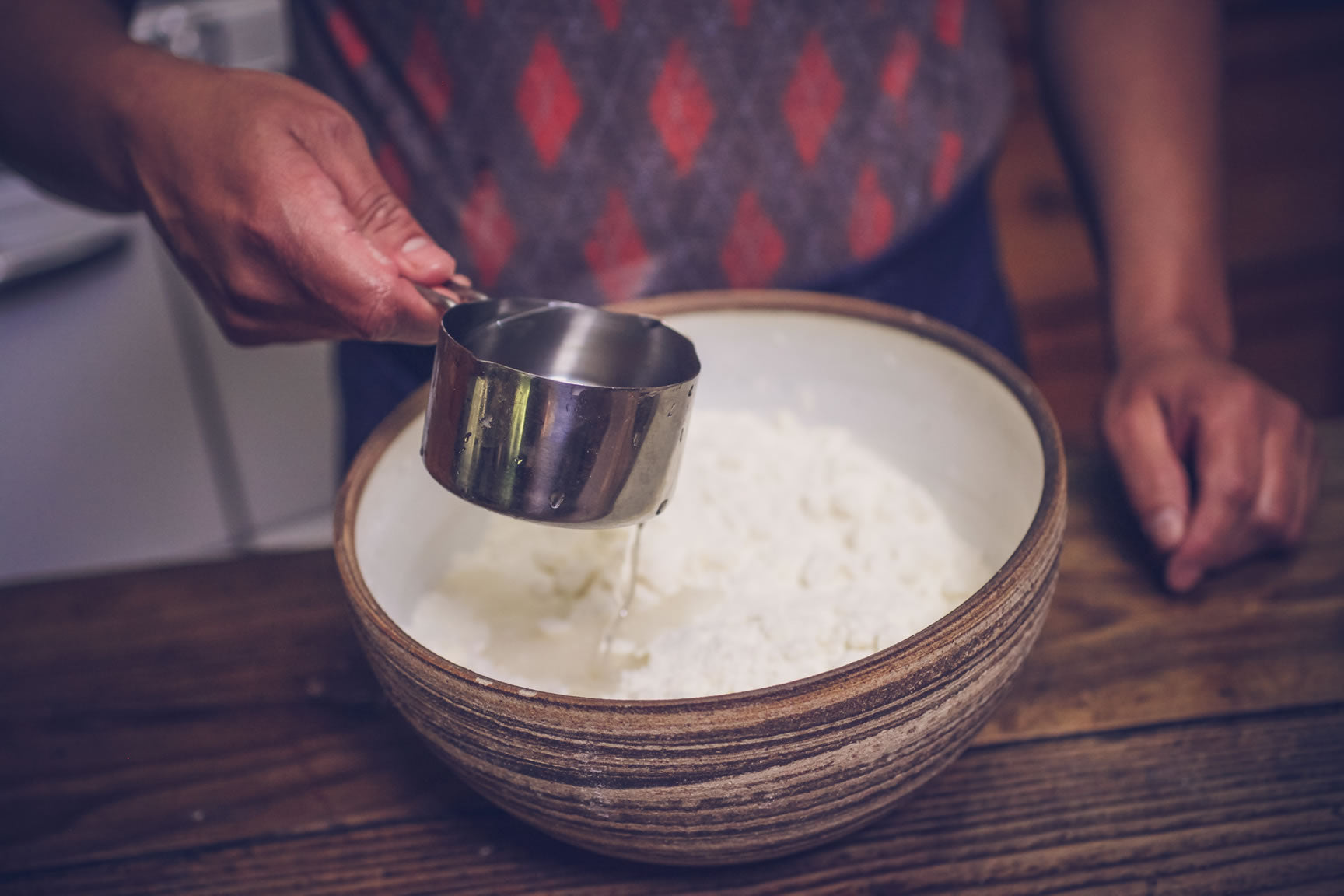

Turn the dough out of the bowl onto a clean, smooth surface. Form a ball with your hands.
Quarter the dough. Form it into neat disks, so that it will roll out better when the time comes to use it.
 Wrap in plastic or parchment paper and let the dough chill in the refrigerator for at least an hour, up to overnight. For longer storage of the unbaked dough, keep it in the freezer.
Wrap in plastic or parchment paper and let the dough chill in the refrigerator for at least an hour, up to overnight. For longer storage of the unbaked dough, keep it in the freezer.
Preheat the oven to 425°F.
Prepare the filling. Slice open the squash and remove the seeds.  The skin of delicata squash is so, ahem, delicate, that it can be left on. Remove the seeds, and cut the squash into 1/2” slices.
The skin of delicata squash is so, ahem, delicate, that it can be left on. Remove the seeds, and cut the squash into 1/2” slices.
Arrange the squash slices on a baking tray, and drizzle them with olive oil, salt, and pepper to taste. 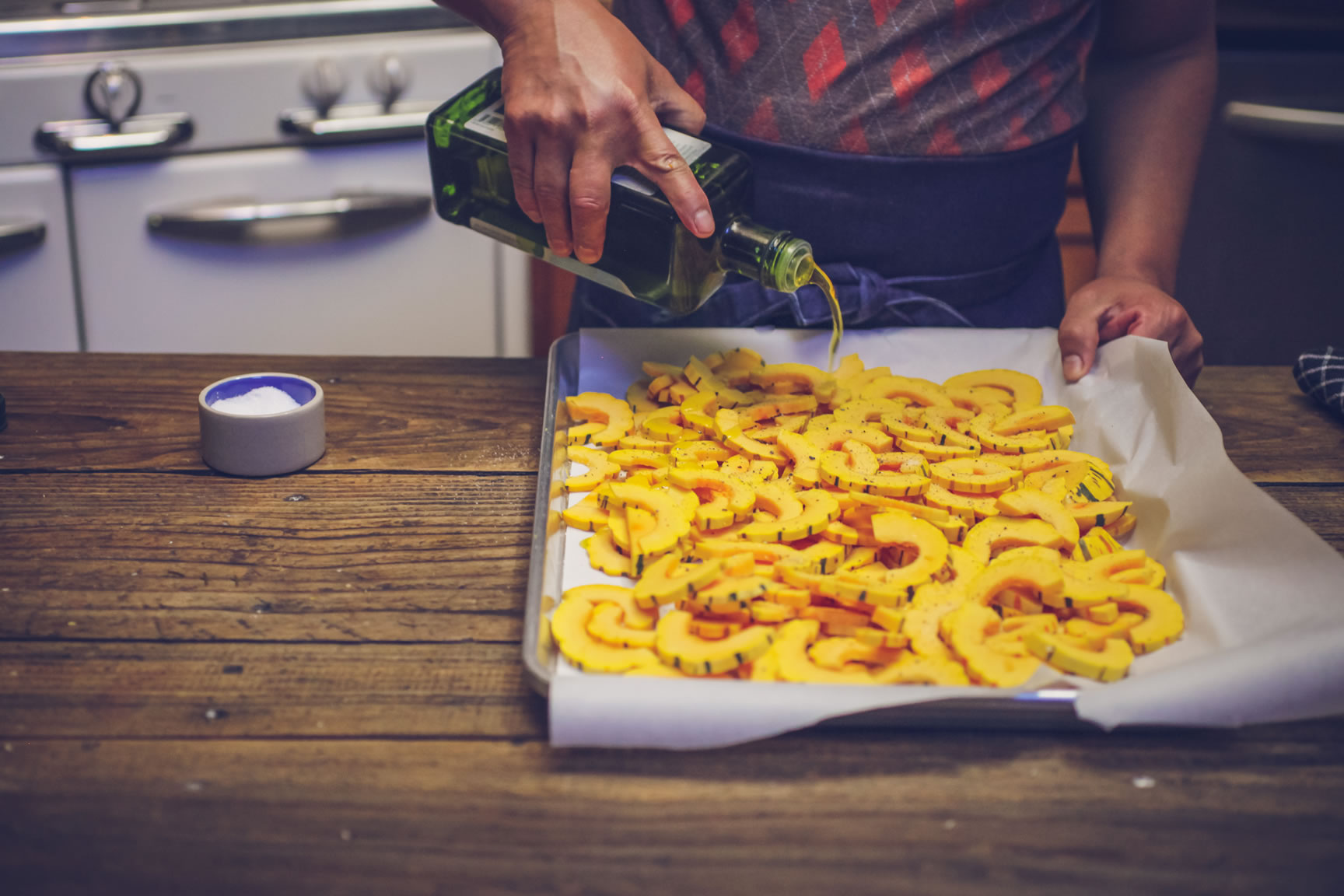
Bake the squash at 425 for about 15 minutes. Daniel calls this “the golden temperature. It’s aggressive,” he says, “but it gives a beautiful golden color to whatever you’re cooking. “ We love us some Maillard reaction.
Remove the squash from the oven, but leave the oven on. You’re just getting started.
Meanwhile, slice the onions into thin rings. 
In a cast-iron pan, melt a generous amount of butter. Add the onions and cook over medium heat until the onions are golden, fragrant, and just beginning to brown on the edges. Set aside.
Heat another several tablespoons of butter in a cast iron skillet over medium-high heat. When the butter has melted, sprinkle the sage leaves into the hot butter. 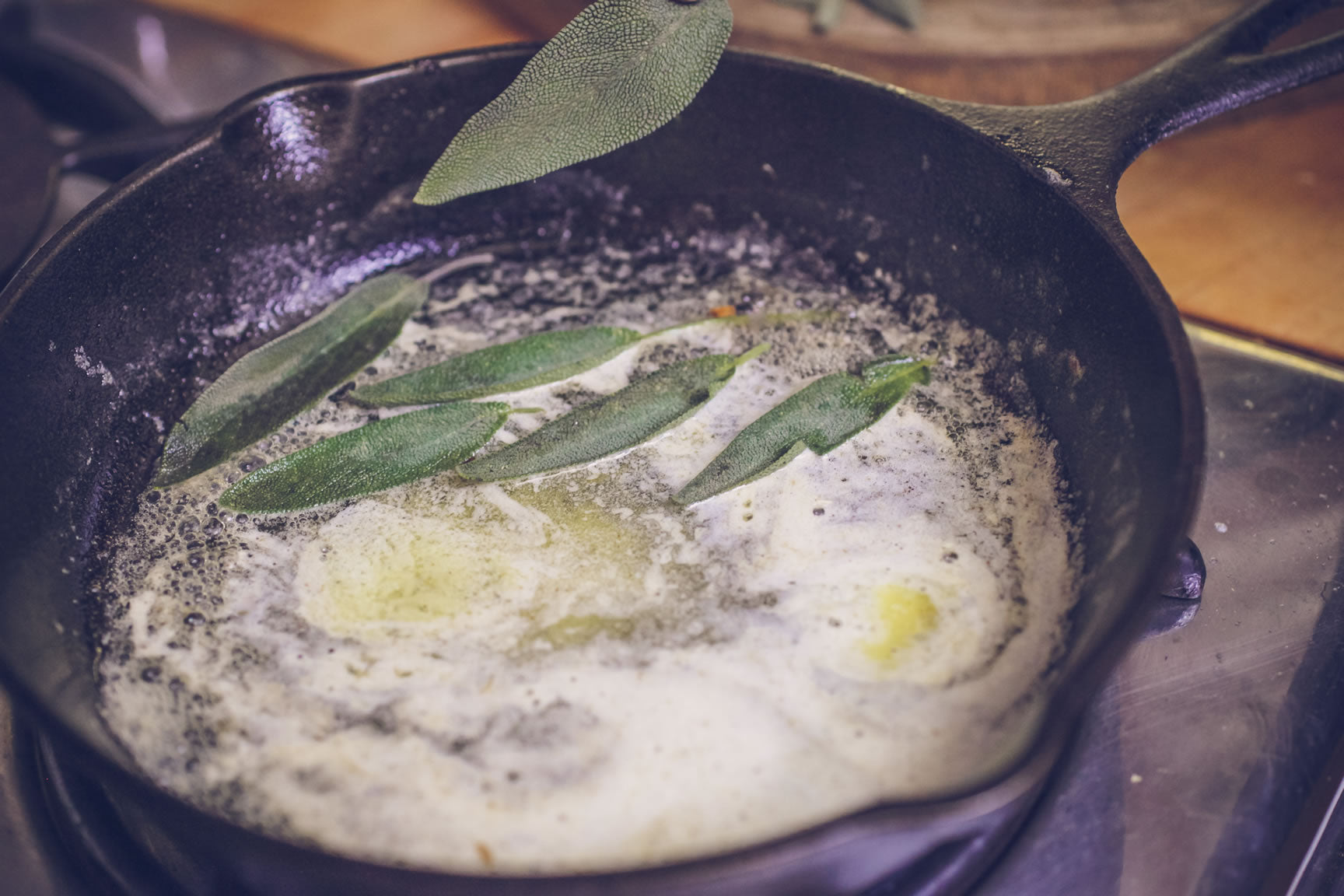 Cook until the leaves are crisp and toasted but not burnt. Remove from the heat and drain on paper towels.
Cook until the leaves are crisp and toasted but not burnt. Remove from the heat and drain on paper towels.
Remove the tart dough from the fridge, and allow it to rest for about 20 minutes.

Sprinkle a work surface with a light dusting of flour. Set the chilled dough on the work surface and flour it lightly, as well. Roll the dough out, using the rolling pin to work from the center of the dough outward in radiating spokes.
 Mend any tears by pushing the dough back together and rolling over it again. The dough should be as uniformly even and round as possible, about 1/4” thick.
Mend any tears by pushing the dough back together and rolling over it again. The dough should be as uniformly even and round as possible, about 1/4” thick.
Fold the dough in half, and then over again, so that it makes a triangle shape; this makes it easy to move without tearing.

 Line a round pizza pan with parchment paper. Gently unfold the tart dough onto the papered baking pan.
Line a round pizza pan with parchment paper. Gently unfold the tart dough onto the papered baking pan.
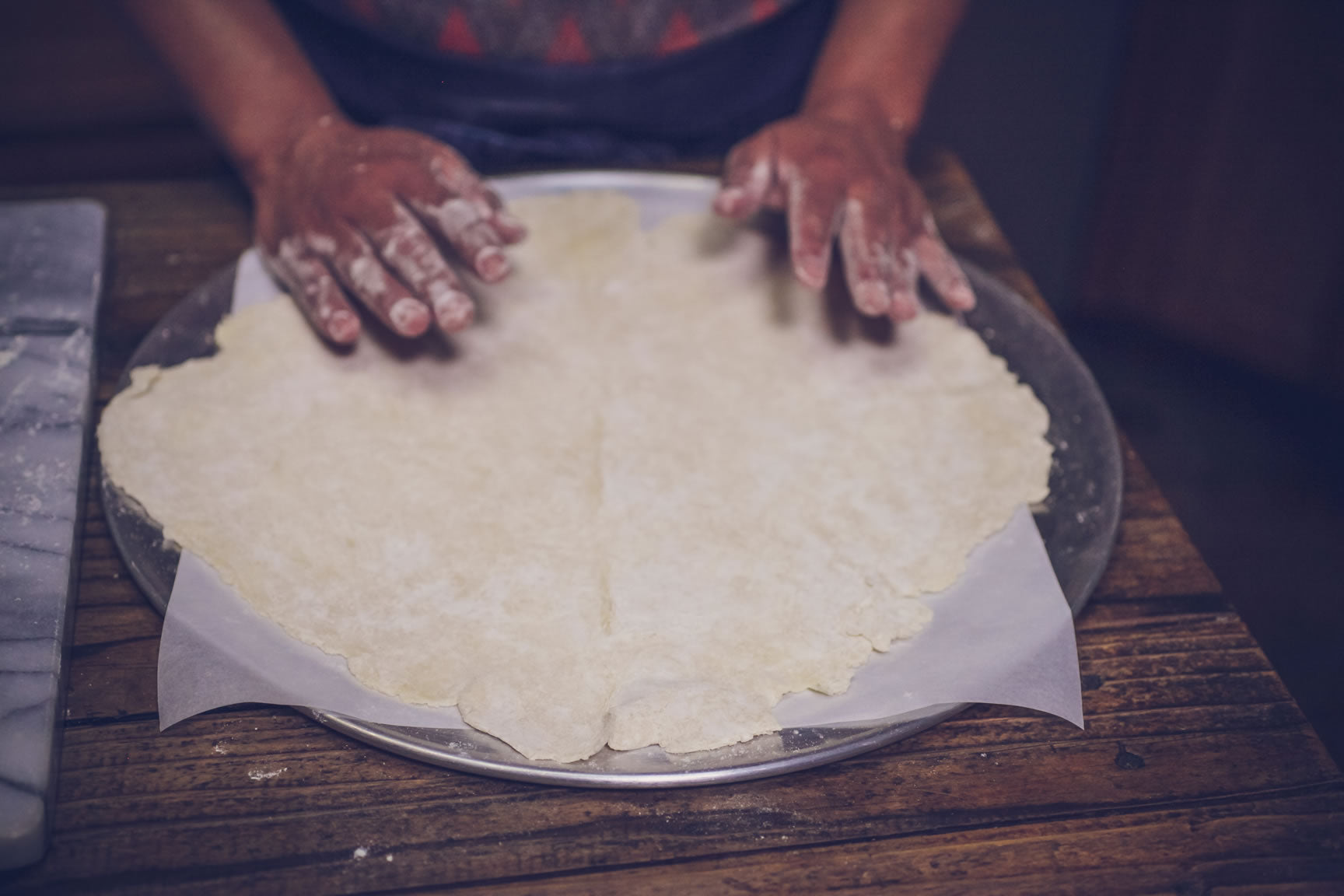 Stir the garlic oil, then drizzle it over the tart dough.
Stir the garlic oil, then drizzle it over the tart dough.

Spread the onion mixture over the top of the dough, leaving a margin of 2-3 inches around the outside of the dough. Arrange the roasted squash slices over the top of the onions.
Arrange the roasted squash slices over the top of the onions.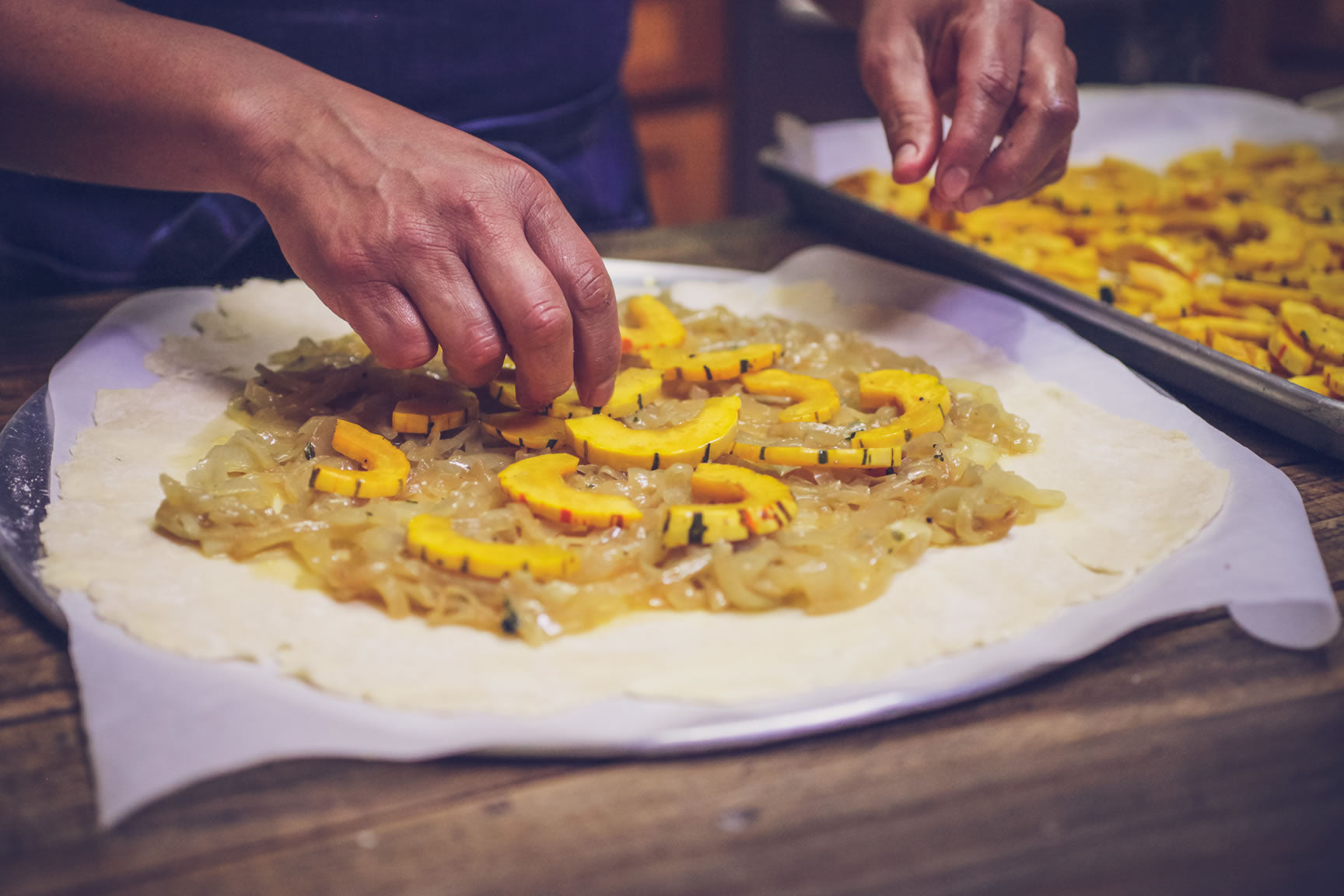 Fold the edges of the tart dough over to cover just the edge of the arranged vegetables.
Fold the edges of the tart dough over to cover just the edge of the arranged vegetables.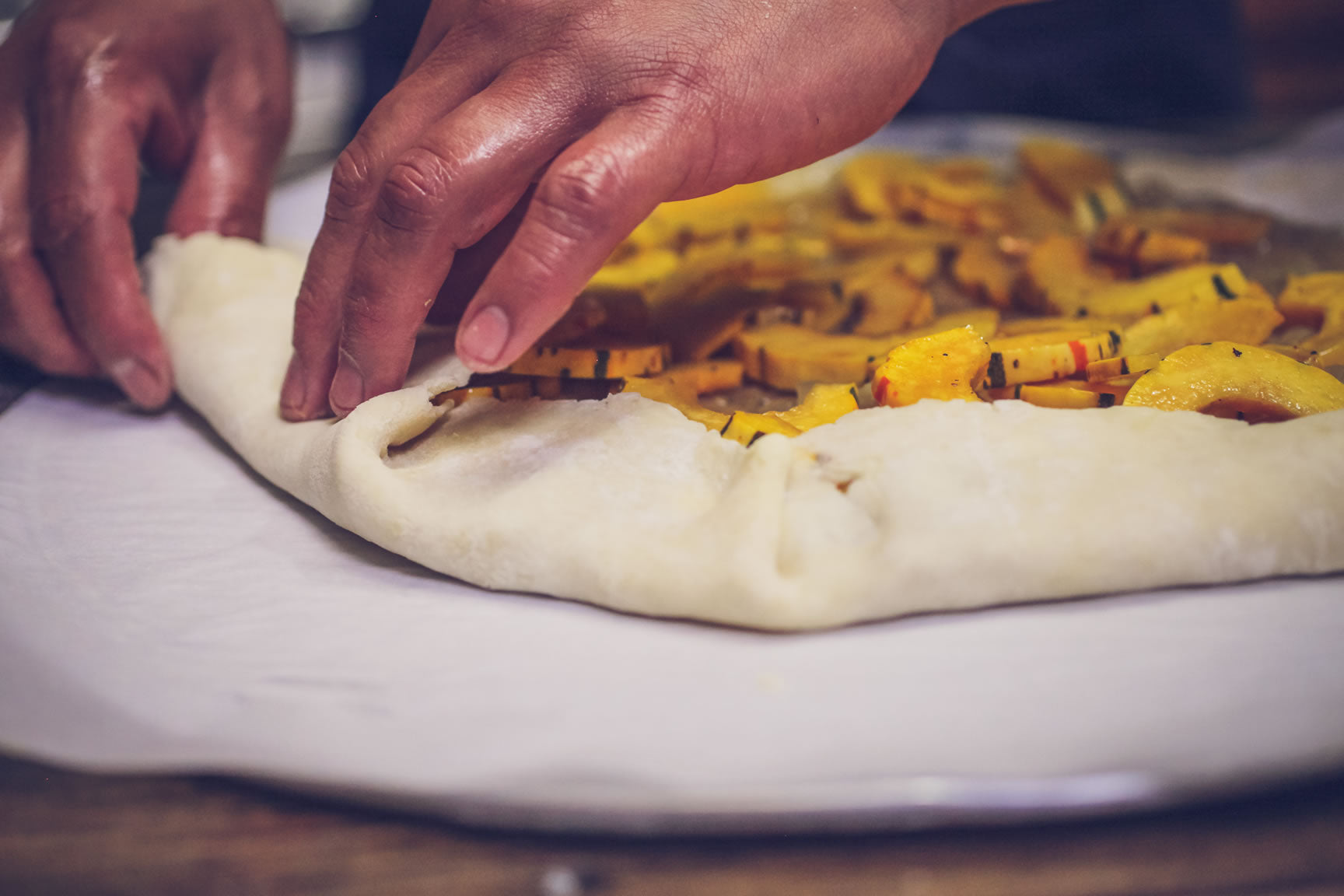 Beat an egg, and brush it over the top of the tart dough, so it browns nicely.
Beat an egg, and brush it over the top of the tart dough, so it browns nicely. Finally, sprinkle the tart with red pepper flakes. Grind a generous amount of black pepper over the top of the tart.
Finally, sprinkle the tart with red pepper flakes. Grind a generous amount of black pepper over the top of the tart. Slip the tart off of the pan, into the oven, so that it rests on the oven shelves on the parchment paper. This will make for the brownest, most delicious crust.
Slip the tart off of the pan, into the oven, so that it rests on the oven shelves on the parchment paper. This will make for the brownest, most delicious crust. Bake the tart at 425°F for 20 minutes, then rotate it, to avoid blackening in hot spots. Bake for another 10 minutes and then remove from the oven.
Bake the tart at 425°F for 20 minutes, then rotate it, to avoid blackening in hot spots. Bake for another 10 minutes and then remove from the oven.
Grate about 3 Tbs pecorino over the the top of the tart while it is still hot.
Arrange the fried sage leaves over the top of the tart. Let it cool for a moment or two. If you can. If you care to. Share it with friends. Dig in.
Let it cool for a moment or two. If you can. If you care to. Share it with friends. Dig in.
Over to You
It’s part of our mission here at Mountain Feed to help you make delicious, sustainable, homemade food more often. Stop by and say hello on Facebook, Twitter, Instagram or Pinterest. Or, as always, you can do it the old fashioned way and come by the store to speak with one of our in-house experts.
